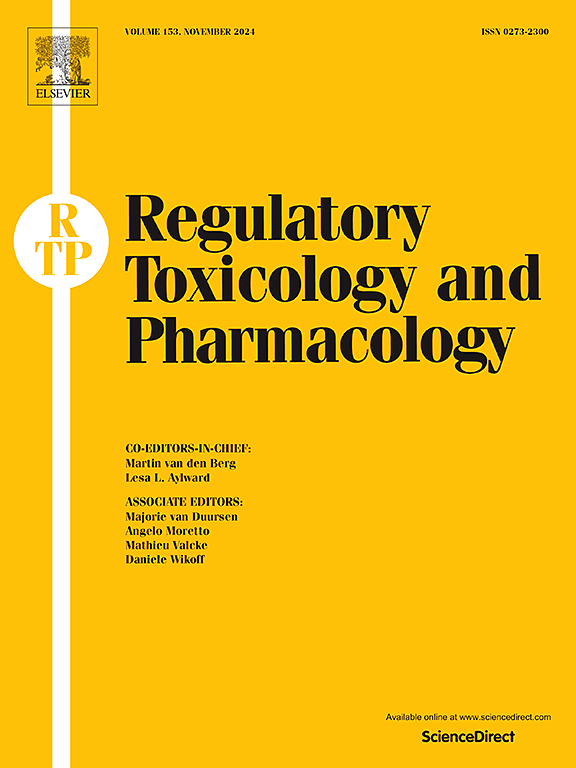Transforming the Evaluation of Agrochemicals: A Conceptual Model
IF 3.5
4区 医学
Q1 MEDICINE, LEGAL
引用次数: 0
Abstract
Globally, regulatory authorities face the challenge of integrating advances in science and technology into existing frameworks for agrochemical risk assessment. Addressing this challenge is critical to meeting the demands of food safety and quality for a growing population. To support this shift, the Health and Environmental Sciences Institute (HESI) convened a multi-stakeholder committee of international scientists. Through a problem formulation-led strategy, the committee developed the Transforming the Evaluation of Agrochemicals (TEA) conceptual model to guide the adoption of new methods, best practices, and technologies into regulatory practice for agrochemical safety. The core of the model incorporates the well-established tiered approach routinely used for identifying and characterizing hazards and assessing exposures; however, the model strategically identifies three sequential elements: exposure-led, adaptability, and inclusion of new science. The central core is then surrounded by layers with additional elements, namely: fit-for-purpose over time, adapt to global need, adapt to local need, create incentives, data sharing and transparency, and build trust. Collectively, these ten elements and their intersections result in a novel, TEA conceptual model with elements that have not been simultaneously implemented in any regulatory data package to date. In providing guiding principles, two examples of regulatory applications, and a concise summary of how this model supports an opportunity to go beyond next generation risk assessments focused primarily on alternative approaches to animal testing, we demonstrate the utility of the TEA conceptual model as a tool and mechanism supporting a structured and systematic application towards the intended transformation of agrochemical evaluations.
转化农用化学品评价:一个概念模型。
在全球范围内,监管当局面临着将科学技术进步纳入现有农用化学品风险评估框架的挑战。应对这一挑战对于满足不断增长的人口对食品安全和质量的需求至关重要。为了支持这一转变,健康与环境科学研究所(HESI)召集了一个由国际科学家组成的多方利益相关者委员会。通过以问题表述为主导的战略,委员会开发了农用化学品评估转型(TEA)概念模型,以指导将新方法、最佳实践和技术应用于农用化学品安全的监管实践。该模型的核心采用了公认的分层方法,通常用于识别和描述危害以及评估暴露;然而,该模型战略性地确定了三个连续的要素:暴露导向、适应性和新科学的包容。然后,核心被其他元素层层包围,即:随着时间的推移,适合目的,适应全球需求,适应当地需求,创造激励,数据共享和透明度,以及建立信任。总的来说,这十个元素和它们的交集形成了一个新的TEA概念模型,其中的元素迄今为止还没有在任何监管数据包中同时实施。在提供指导原则、两个监管应用示例以及该模型如何支持超越主要关注动物试验替代方法的下一代风险评估的机会的简要总结中,我们展示了TEA概念模型作为一种工具和机制的实用性,该工具和机制支持对农用化学品评估的预期转变进行结构化和系统化的应用。
本文章由计算机程序翻译,如有差异,请以英文原文为准。
求助全文
约1分钟内获得全文
求助全文
来源期刊
CiteScore
6.70
自引率
8.80%
发文量
147
审稿时长
58 days
期刊介绍:
Regulatory Toxicology and Pharmacology publishes peer reviewed articles that involve the generation, evaluation, and interpretation of experimental animal and human data that are of direct importance and relevance for regulatory authorities with respect to toxicological and pharmacological regulations in society. All peer-reviewed articles that are published should be devoted to improve the protection of human health and environment. Reviews and discussions are welcomed that address legal and/or regulatory decisions with respect to risk assessment and management of toxicological and pharmacological compounds on a scientific basis. It addresses an international readership of scientists, risk assessors and managers, and other professionals active in the field of human and environmental health.
Types of peer-reviewed articles published:
-Original research articles of relevance for regulatory aspects covering aspects including, but not limited to:
1.Factors influencing human sensitivity
2.Exposure science related to risk assessment
3.Alternative toxicological test methods
4.Frameworks for evaluation and integration of data in regulatory evaluations
5.Harmonization across regulatory agencies
6.Read-across methods and evaluations
-Contemporary Reviews on policy related Research issues
-Letters to the Editor
-Guest Editorials (by Invitation)

 求助内容:
求助内容: 应助结果提醒方式:
应助结果提醒方式:


